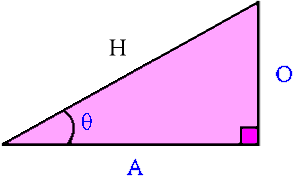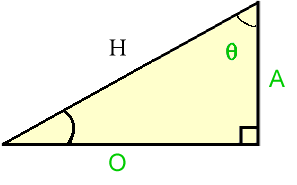Hi guys. We finished Chapter 4 yesterday. I find this chapter is quite challenging and like what Ms Mala said, practice practice practice. :) This chapter really needs a lot of practice. Hopefully we can do our Chapter 4 Quiz next Tuesday. Damn nervous about it. :(
Thats all from me now.. Till then ~
Friday 30 September 2011
Tuesday 27 September 2011
4.3 Equivalent Trigonometric Expressions
In this subtopic, we have learnt in Blended Learning on Monday. I find this subtopic quite confusing. Therefore, I tried to find some simple explanations for 4.3.
We have come up with the follwing identities:
1st Quadrant:
1. sinx = cos((π/2)-x)
2. cosx = sin((π/2)-x)
2nd Quadrant:
1. -sinx= cos(x+(π/2))
2. cosx= sin(x+(π/2))
key: subtract x from (π/2) and keep answer in radians
These identities connect the cosine and sine of an angle. This means that determining the x value in the cosine part of the equation will help you determine the x-value of sine. This method is used throughout the whole section of lesson 4.3.
Also, keep in mind this important aspect in order to get a better understanding of how these co-function identities in the 1st and 2nd quadrant are created.
cosx= sin(x+(π/2)): This means that doing a phase shift to the left (π/2) radians/units to the sine(x) function, creates the cos(x) function. Always think about transformations when dealing with all the other Co function identities as well. It happens for both the Co function identities for angles in the first quadrant and the Co function identities for angles in the second quadrant.
**I know the explanation is too wordy but try to understand though :)
In simpler manner, here's the trig cofunction identities :
For real number or angle measured in radians, theta, the following cofunction identities exist;
__________________________________________________________________________
_________________________________________________________________________
Hopefully this is helpful :)
We have come up with the follwing identities:
1st Quadrant:
1. sinx = cos((π/2)-x)
2. cosx = sin((π/2)-x)
2nd Quadrant:
1. -sinx= cos(x+(π/2))
2. cosx= sin(x+(π/2))
key: subtract x from (π/2) and keep answer in radians
These identities connect the cosine and sine of an angle. This means that determining the x value in the cosine part of the equation will help you determine the x-value of sine. This method is used throughout the whole section of lesson 4.3.
Also, keep in mind this important aspect in order to get a better understanding of how these co-function identities in the 1st and 2nd quadrant are created.
cosx= sin(x+(π/2)): This means that doing a phase shift to the left (π/2) radians/units to the sine(x) function, creates the cos(x) function. Always think about transformations when dealing with all the other Co function identities as well. It happens for both the Co function identities for angles in the first quadrant and the Co function identities for angles in the second quadrant.
**I know the explanation is too wordy but try to understand though :)
In simpler manner, here's the trig cofunction identities :
For real number or angle measured in radians, theta, the following cofunction identities exist;
Co-function Identities for Angles in the First Quadrant:
1) sin x = cos (π/2 – x) AND cos x = sin (π/2 – x)
2) tan x = cot (π/2 – x)
3) csc x = sec (π /2 – x) AND sec x = csc (π/2 – x)
Co-function Identities for Angles in the Second Quadrant:
1) sin (x + π/2) = cos x AND cos (x + π/2) = - sin x
2) tan (x + π/2) = - cot x AND cot (x + π/2) = - tan x
__________________________________________________________________________
sin 30° = cos 60°
sin 40° = cos 50°
sin 50° = cos 40°
sin 60° = cos 30°
Rule: the sum of the degrees should equal to 90°
sin(x) = cos (π/2 – x)
cos(x) = sin (π/2 – x)
- sin 30° = cos 120°
- sin 40° = cos 130°
- sin 50° = cos 140°
- sin 60° = cos 150°
Rule: add 90° to – sin (x), subtract 90° to cos (x)
- sin(x) = cos (x + π/2)
cos(x) = - sin (x – π/2)
Using Right Angle to Confirm:
∠C = π/2 – x
sin ∠C = c/b
cos ∠C = a/b <
tan ∠C = c/a
Therefore,
sinx = cos ∠C
sinx = cos (π/2 – x)
_________________________________________________________________________
Example:
Given that sin (π/7) = 0.4338, find the value of cos (5π/14).
Finding the other angle (π/2 – x): 5π/14 = π/2 – x
Isolate x: x = π/2 – 5π/14
Common Denominator: x = 7π/14 – 5π/14
Simplify: x = 2π/14 = π/7
So,
cos (5π/14) = cos (π/2 – π/7) = sin (π/7) = 0.4338
Hopefully this is helpful :)
4.2 Trigonometric Ratios and Special Angles
Trigonometric Ratios
If one of the angles of a triangle is 90º (a right angle), the triangle is called a right angled triangle. We indicate the 90º (right) angle by placing a box in its corner.) Because the three (internal) angles of a triangle add up to 180º, the other two angles are each less than 90º; that is they are acute.
This assignment of the opposite and adjacent sides is relative to θ. If the angle of interest (in this case θ) is located in the upper right hand corner of the above triangle the assignment of sides is then:
Pythagoras Theorem states that a triangle is right angled if and only if
.
This means that given any two sides of a right angled triangle, the third side is completely determined.
For example, if O = 1, A = 2, then  .
.
If H = 5, and O = 3, then  .
.

Note that
Other ratios are defined by using the above three :
Trigonometric Ratios of Special Angles
We have already learnt that trigonometry is the study of relationships between the sides and angles of a triangle. The ratios of the sides in a right triangle with respect to its acute angles are called trigonometric ratios of the angle. The angles of degree 0, 30, 45, 60 and 90 are useful angles in trigonometry, and their numerical values are easy to remember. When two angles add up to 900, then any one angle is the complement of the other. Trigonometric ratios of complementary angles help in simplifying problems. Hopefully this figures will help you guys. Remember to memorize :)) |
Sunday 25 September 2011
4.1 Radian Measure

An arc of a circle is a "portion" of the circumference of the circle.
The length of an arc is simply the length of its "portion" of the circumference. Actually, the circumference itself can be considered an arc length.
The length of an arc (or arc length) is traditionally symbolized by s.
The radian measure of a theta central angle of a circle is defined as the ratio of the length of the arc the angle subtends, s, divided by the radius of the circle, r.
Therefore, we can conclude that :
Relationship between Degrees and Radians :

Preface
Hi guys.
We are now in Chapter 4, dealing with Trigonometry. So, I'll try to post some useful notes and also videos for you all. Thanks in advance for watching :)
We are now in Chapter 4, dealing with Trigonometry. So, I'll try to post some useful notes and also videos for you all. Thanks in advance for watching :)
Subscribe to:
Posts (Atom)












